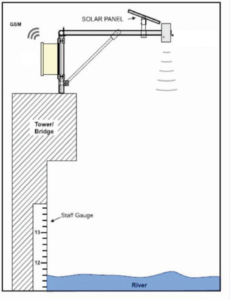Radar Water Level Gauge
A radar sensor measures water level by propagating electromagnetic energy with an antenna. Because radar energy reflects and similarly to light,
objects in the propagation path reradiate the microwave energy back to the radar antenna. The time it takes for the energy to the return to the
energy back to the radar (travel time) is determinted with the radar’s integral digital signal processing units and software.
The resulting travel time is used to determine the distance to the water level.
Pulse radar level transmitters provide water level measurement based on the direct measurement of the running time of microwave pulses transmitted to and reflected from the surface of the river being measured. Pulse radar operates in the time domain and therefore it does not require the FFT analysis that characterizes FM-CW radar.
Since, the running time for a distance of a few metres is measured in nanoseconds. For this reason, a special time transformation procedure is required to enable these short time periods to be measured accurately. The requirement is for a ‘slow motion’ picture of the transit time of the microwave pulses with an expanded time axis. By slow motion it means milliseconds instead of nanoseconds. Pulse radar has a regular and periodically repeating signal with a high pulse repetition frequency (PRF). Using a method of sequential sampling, the extremely fast and regular transit times can be readily transformed into an expanded time signal.
Pulsed radar has several advantages including increased range, lower power consumption, and it does not rely on the Doppler Effect to determine range.
Functions
- Direct, time of flight level measurement.
- Uses a special sampling technique to produce a time expanded intermediate frequency signal.
- The intermediate frequency is produced in hardware and does not require FFT analysis.
- Low processing power requirement mean that practical and very capable two wire, loop powered, intrinsically safe
so our pulse radar can be used in some of the most challenging process water level applications.
Specifications
| Contact-free microwave measuring principle |  |
| Contact-free microwave measuring principle |
| Measuring range: 0.5 – 30 meters |
| Accuracy (linearity, repeatability and hysteresis) 0.03 % or better adjustable measuring interval (typically 5 min for flooding events) |
| Power consumption: ≤ 20 mA Active, ≤ 10 mA sleep |
| Power should be able to be cycled |
| Power input: 10-15 V DC |
| Output interface: as required for data logger specified below |
| Weatherproof, protection IP65 (NEMA 4) or better |
| All accessories (cables, fixing units, etc.) as required |
| Complete tool kit for installation and routine maintenance giving full detail( number of pieces and type) |
| Full documentation and maintenance instructions in English (1 copy per station) |















